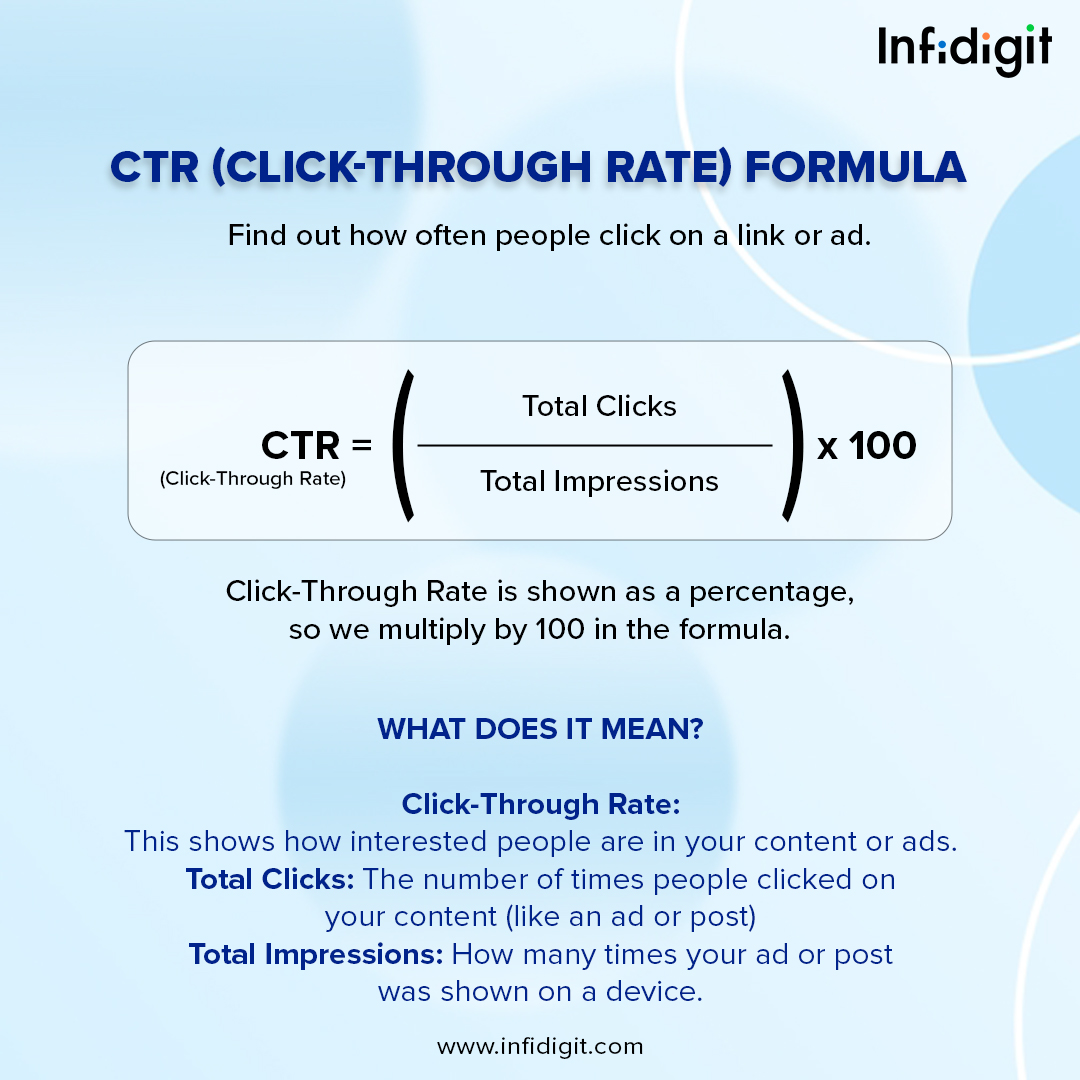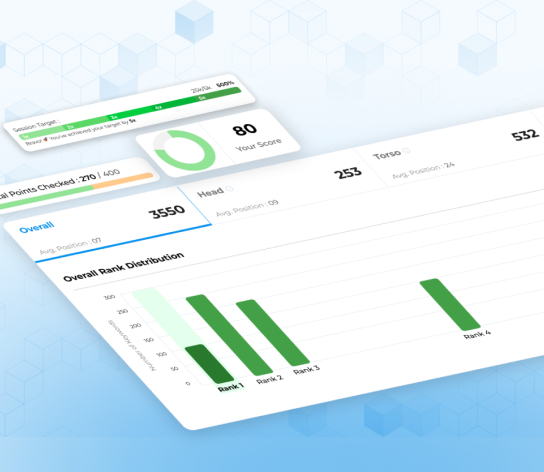Struggling to optimise the CTRs?
Connect with our SEO experts and improve the performance
What is Click-Through Rate (CTR)?
Those engaged in online advertising or email campaigns will consistently encounter the term Click-Through Rate (CTR), a crucial metric that signifies the ratio of viewers who click on a specific link compared to the total viewership of a page, email, or advertisement. Understanding the CTR meaning goes beyond its basic definition; it’s a measurable percentage indicating the number of clicks advertisers receive relative to the total number of ad impressions. A robust click-through rate is not only indicative of your content’s relevance and appeal but also underscores why CTR matters in terms of competitive advantage—it reflects the ad’s success in capturing attention and persuading action. Additionally, a high CTR is associated with better ad placements and lower costs in many advertising platforms.
What is a CTR Calculator?
A CTR calculator is a tool that measures the click-through rate (CTR) of an online campaign or advertisement. It does this by calculating the percentage of users who click on a specific ad relative to the total number of users who have seen it (impressions). The process is simple: the number of clicks collected is divided by the number of impressions. For instance, if there are 50 clicks for 1000 impressions, the CTR is 5%. This calculator facilitates quick analysis for marketers to gauge the effectiveness of their ads and optimize their digital strategies accordingly.
How to calculate the Click-through rate: The CTR Formula
Calculating the Click-through rate (CTR) is straightforward with the CTR Formula, or you can use a CTR calculator to simplify the process, which is both intuitive and universally applicable to various online marketing scenarios. Calculating the click-through rate (CTR) is straightforward with the CTR formula, or you can use a calculator with CTR impressions to simplify the process, which is both intuitive and universally applicable to various online marketing scenarios. To find the CTR, you simply divide the total number of clicks an ad or link receives by the number of times the ad is shown, known as impressions. Generally expressed as a percentage, the formula looks like this:

CTR = (Total Clicks ÷ Total Impressions) x 100%
This essential formula helps you quickly determine the effectiveness of your advertisements or emails in driving user engagement. Moreover, utilizing a CTR calculator tool can expedite this process by automatically calculating the CTR for you once you input the ad clicks and impressions data. For a campaign with 1,000 impressions and 100 clicks, for example, the CTR would be 10%. Such data is invaluable in assessing which campaigns are performing well and resonating with your target audience.
Benefits of Using a CTR Calculator
- Time Efficiency: Instantly get results, saving precious minutes for other marketing tasks.
- Accuracy: Minimizes errors in calculations, providing exact CTR values.
- Performance Insights: Reflects ad quality, indicating which ads resonate with audiences.
- Campaign Benchmarking: Helps compare the performance of multiple campaigns effectively.
- Platform Analysis: Identifies which online platforms yield the best ad engagement.
- Ad Optimization: Assists in making informed, data-driven decisions to improve campaigns.
- Strategic Adjustments: Facilitates redesigns and updates based on the CTR trends observed.
Why Prioritize CTR in Your Metrics?
Understanding the Importance of CTR
When analyzing your online campaigns, it’s crucial to understand the significance of CTR. This metric directly reflects how engaging your content is to your target audience. A robust CTR not only signals interest but also directly influences the visibility of your ads; low CTRs can hinder your content from appearing prominently, which underscores why CTR matters.
A thriving CTR translates to an advertisement or email that resonates well, enticing viewers to go beyond mere impressions and take decisive action. This actionability is a testament to the ad’s relevance and alignment with audience interests—crucial factors for successful marketing engagements.
Additionally, CTR serves as a benchmark to compare different campaigns and advertisements. It also matters because fluctuations in CTR can reflect on other aspects of your marketing strategy, suggesting areas that might need optimization. A comparative analysis of CTRs across various ads can shed light on what content performs best, guiding you to make informed decisions about where to allocate your budget and creative efforts for maximum impact.
Realize the Impact on Revenue
CTR is not just a metric of engagement; it has a clear impact on profitability. When more users click through, there is a higher probability of conversion, leading to increased sales and profits. By optimizing your campaigns for better CTR, you can effectively lower the cost per acquisition, as a higher click-through indicates that you’re reaching and resonating with the right audience. Consequently, this can lead to a more efficient allocation of your advertising spend, ultimately boosting the return on ad spend (ROAS).
It’s important to understand the relationship between click-through rate (CTR) and profitability. This connection shows how making strategic changes to improve CTR can have a real impact on a company’s earnings. Investing in better ad copy, targeting, and placements can boost CTR and transform digital advertising from just getting views to actually making more money.
Frequently Asked Questions
1. When Should I Use an Online CTR Calculator?
You should use an online CTR calculator for quick and accurate calculations during regular performance assessments, such as weekly or monthly reviews, to compare the efficiency of different campaigns or ad creatives, and when optimizing ongoing marketing strategies. It’s ideal for immediately figuring out the effectiveness of your ads and saving time that can be better spent on optimization efforts.
2. What is considered a good CTR?
CTR, or click-through rate, can vary a lot based on the industry and the type of content you’re looking at. However, generally speaking, for display ads, achieving a CTR between 0.5% and 2% is often deemed acceptable, while for search ads, a CTR above 2% typically indicates solid performance. It is crucial, though, to consider the average benchmarks specific to your industry to truly gauge what would be considered “good” for your campaigns. For example, industries like dating services might experience a higher average CTR, while legal services may aim for lower yet impactful rates.
3. How can CTR affect online advertising?
CTR is a pivotal metric in online advertising that measures the ratio of user clicks to impressions on ads. A higher CTR generally suggests that the ads are well-targeted and engaging, leading to decreased costs per click. This is particularly evident in platforms like Google Ads and Facebook, where the algorithms often reward engaging ads with better ad placements and more favorable pricing.
On the flip side, a low click-through rate (CTR) could suggest that the ads are not very relevant to the intended audience. This is particularly true on social media platforms like Facebook and Twitter, where a low CTR can result in ad spending being wasted on impressions that do not translate into clicks.
If Google Ads notices a plummet in user engagement, it could imply that your content is not resonating with your audience. Therefore, consistently monitoring and optimizing for high CTR can boost ad visibility and play a significant role in enhancing the overall campaign ROI, driving more traffic to your website, and potentially increasing sales.
4. Can Calculating CTR Impact SEO?
Calculating CTR itself doesn’t impact SEO, but understanding and analyzing CTR can certainly inform SEO strategies. Search engines use CTR as one of the many indicators to gauge the relevance and value of web pages. Incorporating a rigorous analysis of click-through rate (CTR) helps in identifying which keywords or elements have underperformed. This information can then be used to refine or adapt your SEO and keyword strategy for future content.
A high CTR from search results implies that users find your content relevant, which can positively influence your page rankings. Therefore, while the act of calculating CTR doesn’t alter SEO performance, consistently high CTRs can lead to improved search visibility. For organic search performance, focusing on creating compelling titles and meta descriptions can be key tactics for improving CTR and, consequently, SEO.
5. How often should I analyze my CTR?
Analyzing your CTR should be a regular and strategic part of your campaign management routine. For ongoing campaigns, a weekly review of CTR can provide insights into performance trends without getting caught up in daily fluctuations. For shorter or more dynamic campaigns, a daily review might be necessary to make timely adjustments.
However, immediate changes should not be based on short-term data alone. Look for consistent trends and make data-driven decisions over a reasonable time frame to ensure that any alterations to the campaign are genuinely needed.
6. Is CTR used to measure online ads performance?
Yes, the Click-Through Rate (CTR) stands as a critical metric, highly regarded, and beneficial within the sphere of online marketing. Marketing and advertising professionals employ it as a testament to its importance in measuring how much an audience interacts with a specific ad, including the performance of targeted email ads.
CTR delivers immediate and unequivocal insights into how attractive an advertisement is to its intended audience and is crucial for fine-tuning, providing precise data that aids in improving tactics and the wise allocation of advertising budgets. While CTR is an essential measure, it’s crucial to analyze it alongside other significant indicators like conversion rates and ROI to fully comprehend an ad’s success, especially in cost-effective channels like email advertising, and inform evidence-based decisions in future marketing initiatives.
Free SEO Tools
How useful was this post?
5 / 5. 1








